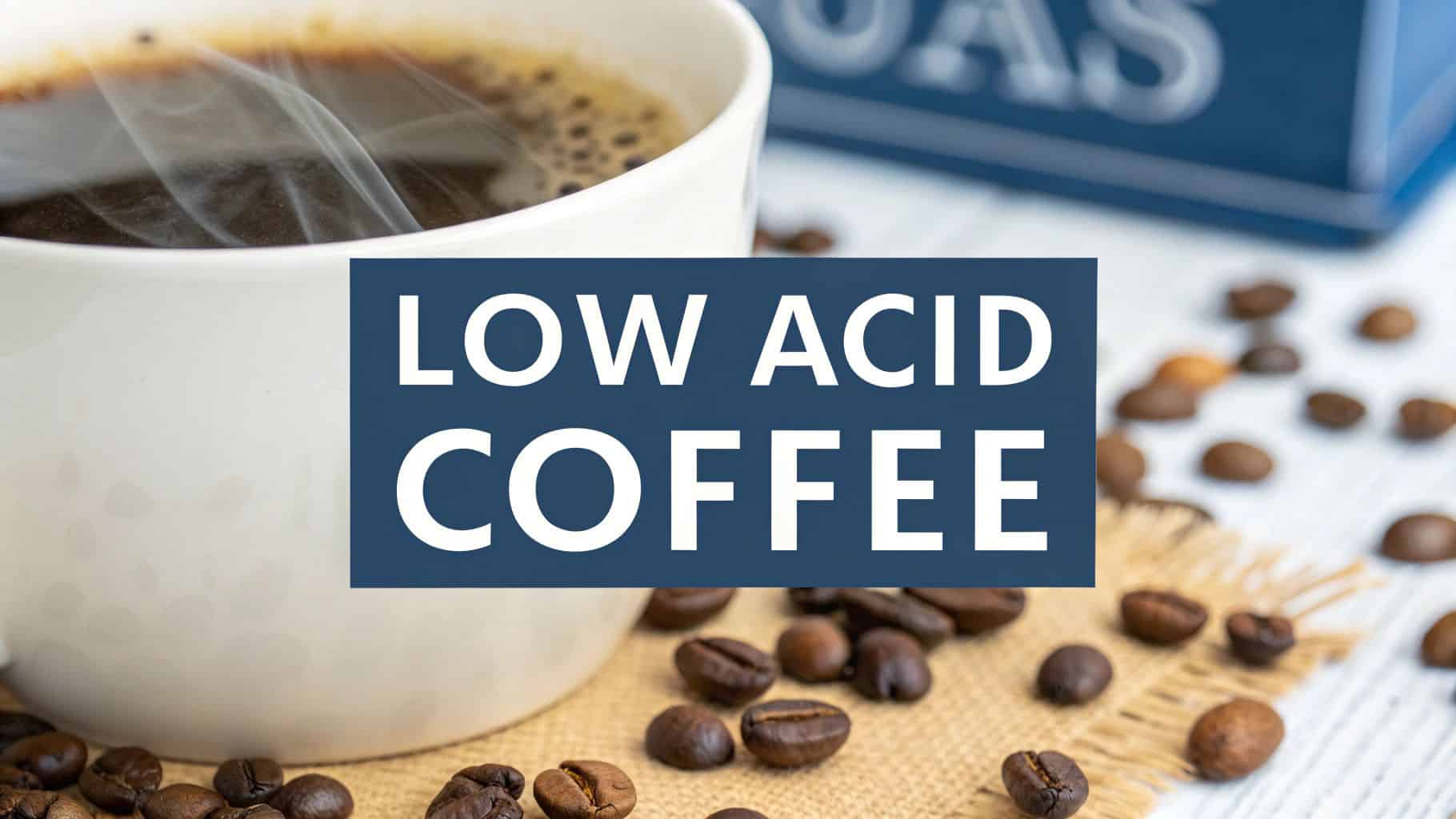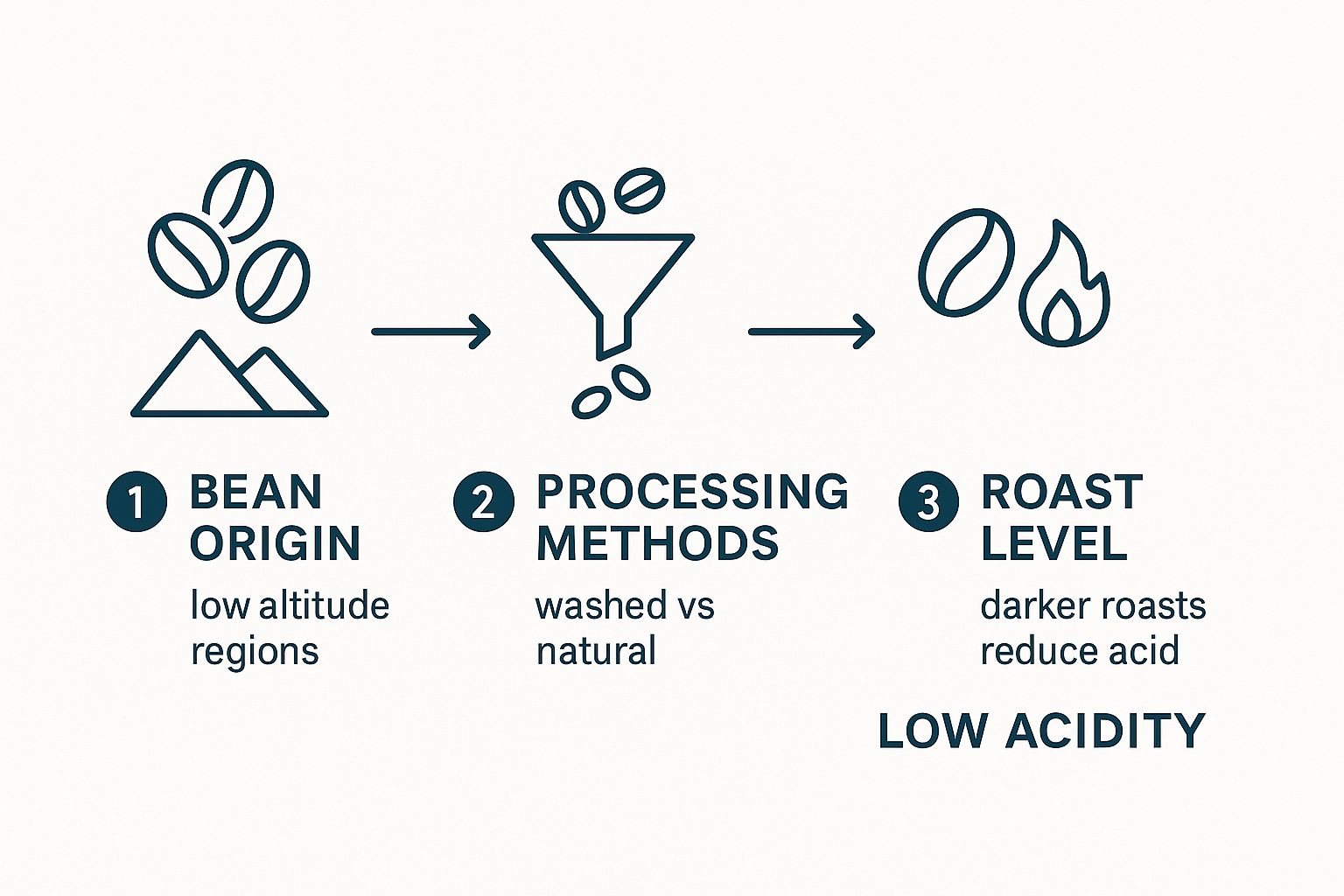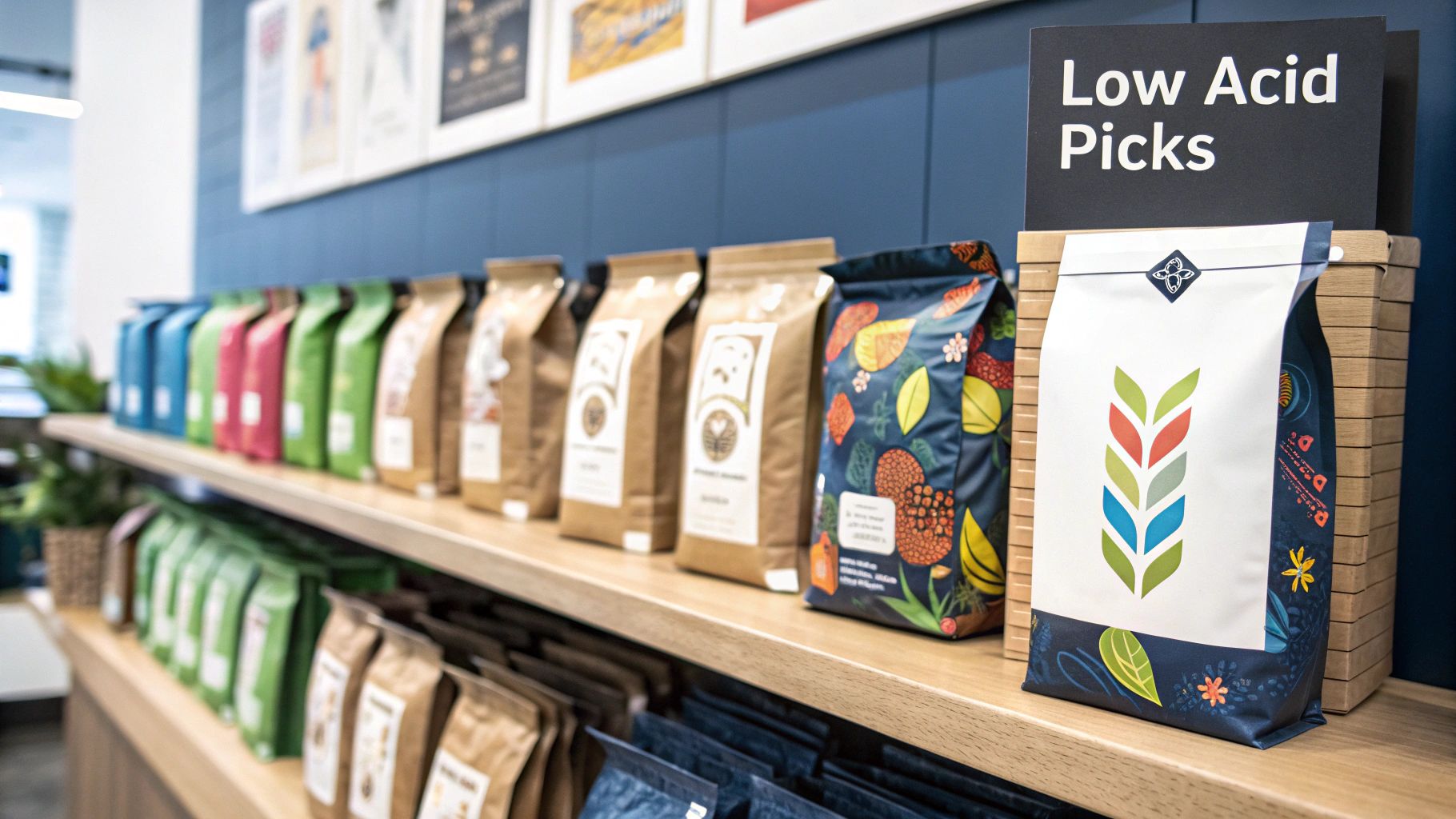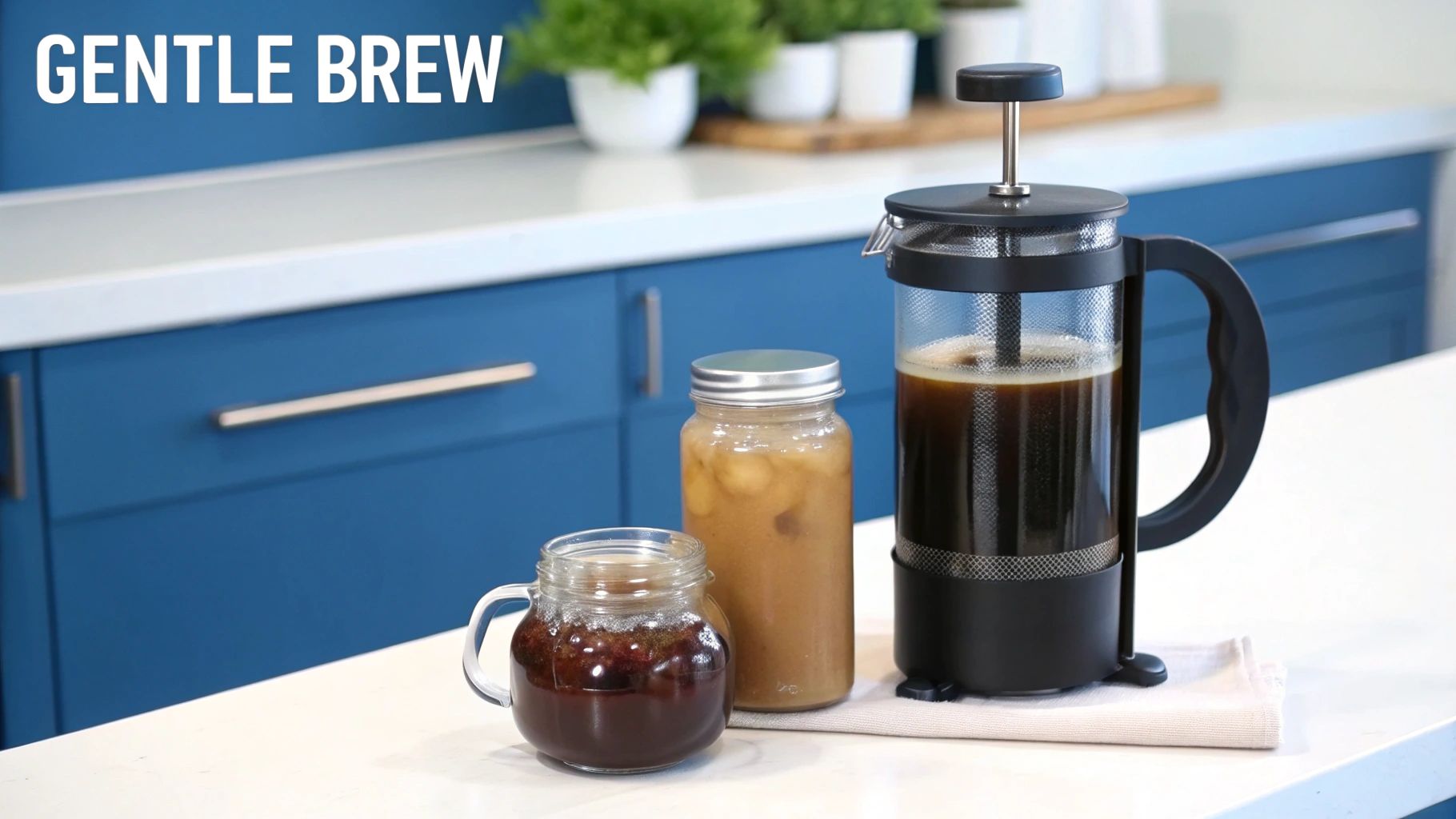UK’s Best Low Acid Coffee Brands for a Smoother Brew

If your daily coffee ritual sometimes comes with a side of heartburn or stomach trouble, you're certainly not alone. Think of this guide as your first step towards a smoother, more comfortable brew as we explore the world of the best low acid coffee brands in the UK. We'll show you how to get back to enjoying rich, flavourful coffee, just without the harshness that can upset your system.
Why Your Morning Coffee Might Be Causing Discomfort
For so many of us, a morning coffee is an indispensable part of the day. It’s a comforting routine that kick-starts focus and energy. Yet for a growing number of people, that beloved cup can bring on unwelcome effects like acid reflux, heartburn, or just a general feeling of stomach sensitivity.
This discomfort often boils down to the natural acids found in coffee beans, particularly compounds like chlorogenic and quinic acids. While these are the very things that contribute to the bright, complex flavour profiles we coffee lovers appreciate, they can also stimulate excess stomach acid in some people.
Understanding the Source of Discomfort
The issue isn't always the coffee itself but rather how your body reacts to it. Think of it like a spicy curry; some people can happily enjoy the most fiery vindaloo without a problem, while others find even a mild korma is too much to handle. In the same way, your personal sensitivity to coffee's acidity determines whether you feel that discomfort.
Several factors come together to influence a coffee's final acidity level, turning what should be a pleasant experience into a source of irritation. These include:
- Bean Origin: Coffee grown at high altitudes often develops higher acidity as a natural defence mechanism, which translates into a sharper flavour in the cup.
- Roast Level: Lighter roasts tend to preserve more of the beans' original acidic compounds, whereas darker roasts break them down significantly.
- Brewing Method: How you actually make your coffee—from the water temperature to the grind size—can dramatically change how much acid is extracted.
This guide will take you on a journey from the coffee farm right to your cup, uncovering how bean origin, processing, and roasting style all contribute to a gentler coffee experience. Get ready to find your perfect match and reclaim your love for coffee, discomfort-free.
Fortunately, you don't have to give up on coffee entirely. By choosing from a selection of low acid coffee brands, you can find a brew specifically crafted to be kinder to your digestive system. On top of that, tweaking your preparation method, such as exploring the ideal settings in a comprehensive coffee grind size guide, can reduce acidity even further.
What Actually Is Coffee Acidity?
When you hear ‘acidity’ in coffee, it's easy to picture something sour that’ll upset your stomach. But in the world of speciality coffee, it means something completely different—and it’s actually a good thing. For coffee experts, acidity is a prized flavour note, the quality that makes a coffee feel lively and vibrant on your tongue.
Think of it like the difference between fruits. The sharp, zesty tang of a fresh green apple is a classic example of high acidity. On the other end of the spectrum, you have the smooth, mellow sweetness of a ripe pear. Both are delicious, but they offer completely different sensations. That spectrum of flavour is exactly what coffee pros mean when they talk about acidity.
This bright, pleasant taste comes from a whole cocktail of natural acids inside the coffee bean. The catch is that some of these same acids, especially in high amounts, can cause the digestive issues some people experience. The whole point of low acid coffee brands is to carefully reduce the troublesome acids while keeping all the delightful flavour.
The Two Faces of Acidity: Good vs Bad
To really get why some coffees are so much smoother than others, you need to understand the difference between flavour acidity and pH acidity. One is about what you taste, and the other is a straight-up scientific measurement.
- Flavour Acidity: This is the desirable ‘brightness’ or ‘liveliness’ that adds complexity and excitement to a brew. Acids like citric (think lemon) and malic (think apple) are responsible for these lovely, fruity notes.
- pH Acidity: This refers to where coffee sits on the pH scale. Most coffee hovers around a pH of 5, making it less acidic than orange juice or even a tomato. It's the types of acids, not just the overall pH level, that can cause trouble.
The real culprits behind stomach sensitivity are often chlorogenic and quinic acids. While chlorogenic acid has antioxidant benefits, it can break down during brewing into quinic acids. These are what create a harsher, more sour taste and can encourage your stomach to produce more acid.
This delicate balance is where the art of coffee roasting truly shines. A skilled roaster knows exactly how to treat a bean to tone down the harsh-tasting acids while bringing out the ones that create a beautiful, complex flavour profile. You can dive deeper into how roasters pull this off by exploring different coffee roasting profiles explained in our detailed guide.
The Key Acids Found in Coffee
A single coffee bean is a tiny chemical powerhouse, but a few key acids play the biggest roles in how your coffee tastes and how your body reacts to it. These are the main players:
-
Chlorogenic Acid (CGA): This is one of the most common acids in green, unroasted coffee beans. It’s known for its antioxidant properties, but it's also a primary source of bitterness and can be tough on a sensitive stomach.
-
Quinic Acid: This acid forms when chlorogenic acid degrades, which can happen in stale coffee or a brew that’s been sitting around too long. It’s responsible for that sour, astringent taste and is strongly linked to stomach irritation and acid reflux.
-
Citric Acid: Just like in citrus fruits, this acid brings a bright, tangy quality to many high-altitude Arabica coffees, especially those from Africa.
-
Malic Acid: Reminiscent of apples or pears, this acid provides a smooth, crisp acidity that adds a layer of clean, sweet flavour to the cup.
The growing focus on digestive health has really pushed this niche forward. The global low-acid coffee market was recently valued at around $2.34 billion, and it's set to grow as more people look for stomach-friendly options. We're seeing this trend mirrored right here in the UK’s expanding speciality coffee scene, opening the door for more innovative low acid coffee brands to thrive. You can read more about the global low-acid coffee market trends and its projected growth.
The Craft Behind Creating Low Acid Coffee
Creating a coffee that’s both flavourful and easy on the stomach isn’t just a happy accident; it’s a deliberate craft. The journey from a green coffee cherry to a smooth, low acid brew is shaped by intentional choices at every single stage. There are three main factors that work together to define a coffee's final acidity level, turning a potentially sharp bean into a mellow, deeply satisfying cup.
This whole process begins thousands of miles away, long before the beans even see a roaster. The origin, processing, and roasting style are the three pillars that support the creation of exceptional low acid coffee. Getting your head around how these influence the final product is the key to appreciating the care that goes into every bag.
The infographic below breaks down this three-step journey, from the bean's origin to its final roast level, showing how each stage helps dial down the acidity.
As you can see, a lower acidity profile is achieved by combining low-altitude growing conditions, specific processing methods, and a darker roast.
Bean Origin And Altitude
The story of a low acid coffee begins with where it was born. The altitude at which a coffee cherry grows has a huge impact on its chemical makeup. Beans grown at high elevations, like those from Kenya or Ethiopia, tend to face harsher conditions and mature more slowly. This leads them to develop more complex and bright-tasting acids, almost like a natural defence mechanism.
On the other hand, coffee grown at lower altitudes in places like Brazil, India, and Sumatra matures more quickly in warmer climates. This environment encourages a completely different flavour profile—one that’s naturally lower in acidity and often packed with rich, earthy, and chocolatey notes. These beans are the perfect starting point for crafting a smoother brew.
When you're on the hunt for low acid coffee brands, you'll often notice beans sourced from these specific low-altitude regions. Their inherent mellow character makes them a perfect canvas for roasters to work with.
Processing Methods
Once the coffee cherries are picked, the way the bean is separated from the fruit pulp dramatically changes its final taste and acidity. This stage, known as processing, is a crucial step in developing flavour. Two main methods are used, and each one gives a different result.
The "washed" process involves removing the fruit pulp from the bean with water before it’s dried. This technique produces a very clean, bright, and often more acidic cup because it really highlights the bean's natural characteristics.
Conversely, the "natural" or "dry" process involves drying the entire coffee cherry with the bean still inside. This allows all the sugars and compounds from the fruit to soak into the bean, resulting in a sweeter, heavier-bodied coffee with noticeably lower acidity. It’s a popular choice for many low acid coffee brands aiming for that smooth, rounded profile.
The Roaster's Crucial Role
The final, and perhaps most critical, stage is roasting. This is where a skilled roaster can artfully transform the raw green beans, breaking down those harsh acids while developing rich, deep flavours. The secret lies in the roast level and duration.
A longer, slower roast gives the acidic compounds more time to break down. While light roasts are known for preserving bright, fruity acids, darker roasts are celebrated for their smoothness. Here’s a quick look at how roast levels affect acidity:
- Light Roast: Keeps a high level of chlorogenic acid, leading to a bright, tangy flavour.
- Medium Roast: Finds a middle ground, breaking down some acids while keeping some of the bean's original character.
- Dark Roast: Significantly breaks down chlorogenic acids, resulting in a bold, rich, and much less acidic coffee. This is why French and Italian roasts are often recommended for sensitive stomachs.
Mastering this process takes immense skill and precision. Roasters have to carefully control temperature and time to hit that sweet spot where acidity is minimised and flavour is maximised. If you're curious to have a go yourself, you can learn more about the fundamentals of coffee roasting at home in our guide.
Top Low Acid Coffee Brands Available in the UK
Trying to find a great coffee when you've got a sensitive stomach can feel like a bit of a minefield. But the good news is, the UK coffee scene is absolutely buzzing with brilliant roasters who care just as much about creating a gentle, low acid brew as they do about incredible flavour. We’ve done the legwork and picked out some of the best low acid coffee brands out there to help you find your perfect, fuss-free cup.
This list features a mix of homegrown UK roasters and some big international names you can easily get your hands on here. For each one, we’ll get into the nitty-gritty of their flavour notes, where they source their beans, and what makes them a top choice for anyone after a smoother coffee experience. Let's kick things off with a brand that really nails this craft.
Spotlight: Seven Sisters Coffee Co
Based in the heart of East Sussex, Seven Sisters Coffee Co has built a solid reputation for its dedication to quality and proper artisanal roasting. While they aren't strictly a "low acid" brand, their whole approach to sourcing and roasting means many of their blends are naturally easy on the stomach. It all comes down to their careful bean selection.
They often showcase single-origin coffees from lower-altitude regions like Brazil, which are inherently less acidic to begin with. Then, through their masterful roasting, they bring out those deep, rich notes of chocolate and nuts while expertly breaking down the harsher acidic compounds. The result? A brew that’s both flavourful and unbelievably smooth.
What really makes Seven Sisters Coffee Co stand out is their oxygen-free roasting environment. This meticulous process helps protect the delicate flavour compounds in the bean, stopping those bitter, sour notes associated with higher acidity from ever developing.
Their focus on quality makes them a fantastic starting point for anyone dipping their toes into the world of gentler brews. You can have a look at their full range of thoughtfully sourced and roasted speciality coffee beans to find something that tickles your fancy.
For a quick rundown of our top picks, here’s a table that breaks down the key features of each brand.
Low Acid Coffee Brands at a Glance
This table offers a quick comparison of our featured low acid coffee brands, highlighting key characteristics to help you make the best choice for your palate and preferences.
| Brand Name | Featured Blend | Roast Level | Key Flavour Notes | Best For |
|---|---|---|---|---|
| Seven Sisters Coffee Co | Varies (e.g., Brazilian single-origin) | Medium-Dark | Chocolate, nuts, incredibly smooth | Those who value artisanal UK roasting and a naturally gentle cup. |
| Volcanica Coffee | Low Acid Coffee Blend | Medium | Chocolate, nuts, hint of tangerine | A reliable, purpose-built blend with a clean, layered taste. |
| Puroast Coffee | Dark French Roast | Dark | Smooth, robust, distinctly non-bitter | Drinkers needing a significantly less acidic coffee without giving up a bold flavour. |
| Purity Coffee | EASE Dark Roast | Dark | Dark chocolate, roasted walnut, brown spice | The health-conscious, wanting a certified organic, lab-tested option. |
| Alex's Low Acid Coffee | French Roast | French Roast (Dark) | Bright, nutty, with chocolate and vanilla notes | Organic coffee fans who love a classic French roast but need a gentler version. |
Each of these brands brings something unique to the table, but all are committed to delivering a smoother, more comfortable coffee experience. Now, let's dive into the details of the others.
Volcanica Low Acid Coffee Blend
You can't talk about low acid coffee without Volcanica coming up, and for very good reason. Their dedicated Low Acid Coffee Blend is specifically designed for coffee lovers with sensitive systems. It’s a thoughtfully balanced mix of Arabica beans sourced from lower-altitude regions, including Brazil and Sumatra.
What you get is a coffee with a naturally low acidic profile and a rich, full-bodied flavour. As a medium roast, it hits that sweet spot between preserving the bean's unique character and mellowing out any harshness.
- Flavour Profile: Expect lovely notes of chocolate, nuts, and a subtle hint of tangerine.
- Roast Level: Medium.
- Best For: Those who want a dependable, purpose-built low acid coffee with a clean and complex taste.
Puroast Low Acid Coffee
Puroast has built its entire brand around the idea of low acid coffee. They use a special roasting process that they claim reduces acidity by up to 70% compared to other big-name brands. Their Dark French Roast is a huge hit with people looking for a bold but smooth experience.
This coffee is all about delivering a powerful, rich flavour without any of the bitterness that sometimes comes with dark roasts. It's a brilliant choice for a daily drinker who needs a brew that is consistently gentle on their digestive system.
- Flavour Profile: Smooth, robust, and noticeably free of bitterness.
- Roast Level: Dark.
- Best For: Anyone needing a seriously less acidic coffee without sacrificing a bold, dark-roast flavour.
Purity Coffee EASE Dark Roast
For those who put a premium on organic and health-conscious choices, Purity Coffee’s EASE blend is a fantastic option. This coffee isn’t just low in acid; it's also USDA Certified Organic and rigorously tested to be free from mould, mycotoxins, and pesticides. Their commitment to clean coffee is second to none.
The EASE blend is a dark roast that gives you a full-bodied coffee with a rounded taste and smooth texture. It’s designed to be easy on the gut, making it the perfect pick for anyone with sensitivities who refuses to compromise on quality.
- Flavour Profile: Rich notes of dark chocolate, roasted walnut, and a hint of brown spice.
- Roast Level: Dark.
- Best For: Health-conscious drinkers looking for a certified organic, lab-tested low acid option.
Alex's Low Acid French Roast
Alex's Low Acid Coffee is another brand that's all about making stomach-friendly brews. They use a unique convection roasting method that avoids scorching the beans, which helps strip away harsh chlorogenic acids and creates an exceptionally smooth coffee. Their French Roast is certified organic and offers a rich, balanced profile.
This coffee is crafted from a blend of beans from Mexico, Nicaragua, and Honduras, giving it a complex yet gentle character. It’s a great shout for those who enjoy the deep, nutty flavours of a classic French roast but can't handle the acidity that usually comes with it.
- Flavour Profile: Bright and nutty with aromatic notes of chocolate, vanilla, and hazelnut.
- Roast Level: French Roast (Dark).
- Best For: Organic coffee fans who love a classic French roast but need a gentler version.
A Niche Carving Its Place in the UK
While global brands like Puroast have been shouting about the health benefits of low acid coffee for a while, the UK market has its own unique vibe. The scene might be dominated by the big chains, but there’s a thriving independent sector. In fact, indie coffee shops make up roughly 63% of the market, which is the perfect breeding ground for specialised brands to find their footing.
These local spots are often keen to team up with roasters offering something different, like locally sourced or specially roasted low acid options. This creates a brilliant pathway for these gentler brews to find their way into the hands of more UK coffee drinkers.
How to Select the Right Low Acid Coffee for You
With so many brilliant low acid coffee brands out there, finding the one that’s just right for you can feel like a bit of a mission. But it doesn't have to be overwhelming. In fact, it's a fantastic opportunity to discover what you truly love in a coffee.
The secret is to focus on a few key factors. By breaking it down, you can confidently pick a coffee that not only agrees with your stomach but also tastes absolutely phenomenal.
Start with Your Preferred Roast Level
The roast level is probably the biggest single factor when it comes to a coffee's final acidity. As we've touched on, the roasting process is a bit like alchemy—it masterfully breaks down those harsh acidic compounds in the beans, paving the way for a much smoother flavour.
As a general rule, the darker the roast, the lower the acidity. This is why you'll find that most low acid specialists lean towards medium-dark and dark roasts.
- Medium-Dark Roasts: These hit a sweet spot. They knock back a good deal of the acidity while still letting some of the bean's original, unique character shine through.
- Dark Roasts (like a French or Italian roast): These are your go-to for an exceptionally smooth, low acid experience. Expect bold, rich, and often chocolatey notes.
If you’re just dipping your toes into the world of gentler coffee, kicking off with a medium-dark or dark roast is a solid game plan. It’s a reliable way to get that smoother brew while you figure out which brands and specific flavours you enjoy most.
Pinpoint Your Favourite Flavour Profile
Beyond the roast, take a moment to think about the actual tastes you crave in your morning cuppa. Low acid coffees are known for their rich and mellow profiles, but that doesn't mean they're all the same. There's a wonderful spectrum of flavours to explore.
Are you someone who loves deep, comforting notes, or do you prefer something with a bit more complexity? Knowing your preferences will help you filter through the options and find a brand that speaks to your palate. Common profiles in low acid coffees often include:
- Nutty and Chocolatey: Imagine flavours like toasted almonds, walnuts, and decadent dark chocolate.
- Earthy and Smoky: Often found in beans from places like Sumatra, these coffees offer a robust, grounding character.
- Sweet and Smooth: Notes of caramel, brown sugar, or even vanilla can come together to create a beautifully rounded and comforting cup.
Take a look at the tasting notes the roaster provides. They're your best clue as to what to expect and will help you zero in on a blend that sounds delicious to you.
Match the Coffee to Your Brewing Method
Finally, don't forget about how you actually make your coffee at home. This plays a massive part in the final result. Certain beans and roasts just sing when paired with the right brewing method, and getting this right will unlock their best possible flavour.
A French press, for example, is fantastic at pulling out the full-bodied, oily character of a dark roast. An espresso machine, on the other hand, is built for finely ground beans that produce that rich, concentrated shot. When you're digging into specific beans, you can often find great advice in guides on the best coffee beans for espresso, which often feature low acidity.
Think about your daily ritual:
- French Press or Pour-Over: You’ll want to look for medium to coarse ground coffee with a bold, rich profile.
- Drip Coffee Maker: A real all-rounder that works beautifully with most medium or dark roasts.
- Espresso Machine: Go for beans that are specifically labelled as an espresso blend or a dark roast to get that classic, intense shot.
By keeping these three things in mind—roast, flavour, and brewing method—you'll be perfectly set to navigate the exciting world of low acid coffee and find a brew that's just right for you.
Brewing Techniques To Further Reduce Acidity
Choosing a great low acid coffee is a brilliant start, but it’s only half the story. The way you actually brew your coffee at home can make a massive difference, turning an already smooth bean into something exceptionally gentle on your palate.
With a few simple tweaks to your routine, you gain a surprising amount of control over the final acidity in your cup. We’re not talking about buying expensive new gear, either. It all comes down to the fundamentals: time, temperature, and how coarse or fine you grind your beans. Get these right, and you’ll unlock the smoothest possible flavour.
The Magic of Cold Brewing
If you are serious about slashing acidity, cold brew is your secret weapon. This method completely flips the script, swapping out high heat for a long, slow steep. By using cold or room-temperature water over 12-24 hours, you gently pull out the rich, chocolatey compounds while leaving many of the bitter, acidic ones behind.
The science is pretty simple, really. Certain compounds in coffee, like chlorogenic acids, just don’t dissolve well in cold water. This means cold brew can have significantly less acidity than its hot-brewed cousin, creating a naturally sweet and incredibly smooth concentrate that’s remarkably kind to your stomach. For a full walkthrough, have a look at our complete guide on how to make cold brew coffee.
Cold brewing isn't just another way to make coffee; it's a chemical transformation. By slowing the whole process down with cold water, you fundamentally change which flavour compounds make it into your cup, resulting in a naturally lower acid profile.
Fine-Tuning Your Hot Brew
Of course, not everyone has the patience to wait 24 hours for their coffee. Luckily, you can still chip away at the acidity of your hot brew by adjusting a few key factors. These small changes can have a surprisingly big impact on the final taste.
-
Go for a Coarser Grind: Finer grinds have more surface area, meaning everything extracts faster—including the acids. A coarser grind slows the whole thing down, leading to a mellower, less aggressive cup.
-
Watch Your Water Temperature: Boiling water is a bit too aggressive for coffee grounds. It can scorch them, pulling out bitter and acidic flavours. Aim for a temperature just off the boil, around 90-96°C, for a much smoother extraction.
-
Shorten Your Brew Time: The longer your coffee grounds sit in hot water, the more acids are pulled out. If you’re using a French press or a pour-over, try knocking a little time off your brew to see if it produces a gentler result.
For a deeper dive into all the techniques, checking out a resource on how to reduce coffee acidity for a smoother cup can give you a comprehensive game plan, covering everything from the bean to your final pour.
Still Have Questions About Low Acid Coffee?
Switching to a gentler brew often brings up a few last-minute questions. It’s completely normal. Let’s clear up some common myths so you can find your new favourite coffee with total confidence.
One of the first things people ask is about caffeine. Does low acid mean low kick? Not at all. The methods used to lower acidity, like choosing specific beans or roasting them darker, don’t really touch the caffeine content. A low acid dark roast will wake you up just as effectively as its regular counterpart.
Then there’s the flavour question—is it going to taste bland or watered down? Absolutely not. A well-crafted low acid coffee isn’t about stripping away flavour; it’s about smoothing out the harsh, acidic edges. You’ll often find these brews are richer and smoother, letting deep notes of chocolate and nuts shine through instead of sharp, tangy tones.
Finding Low Acid Coffee in the UK
So, where can you actually buy these gentler coffees? While you might spot a few options in the big supermarkets, your best bet is usually online or at independent coffee shops. The UK coffee scene is buzzing with speciality offerings, creating the perfect environment for unique low acid brands to thrive.
Many independent coffee shops pride themselves on offering unique experiences and healthier options. This makes them ideal places to discover artisanal low acid coffee brands that you won't find on the high street.
This shift is brilliant for coffee lovers, giving you access to high-quality, stomach-friendly brews that also support local and specialist roasters. You can get more insights into how the UK coffee market is growing and changing. Our goal here is to iron out any final wrinkles, leaving you ready to enjoy a smoother, more comfortable coffee experience.
Ready to discover a coffee that's both flavourful and exceptionally smooth? Explore the artisanal, oxygen-free roasted blends at Seven Sisters Coffee Co and find your perfect, gentle brew today. Visit us at https://sevensisterscoffee.co.uk.





